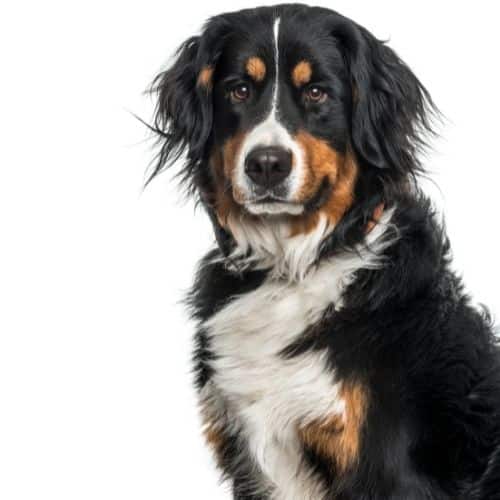Bernese Mountain Dogs are not the most common dogs, especially in large cities. However, as more and more people decide to move in smaller towns, they are slowly becoming more popular. But what about maintaining these large dogs? Do Bernese Mountain Dogs shed and is their tricolored coat easy to groom?
Bernese Mountain Dogs have a stunning appearance. With their fluffy, medium-length coat, they are some of the most adorable gentle giants out there.
Their good looks, combined with gentle and friendly temperament, make them some of the most beloved dogs in areas where they have enough place to roam around.
If you’re considering getting a Bernese Mountain Dog puppy, though, you likely want to know what type of commitment you’re making.
While it’s clear that you’ll have to buy lots of proper dog food and to provide him with a great dog bed, what about grooming? And do Bernese Mountain Dogs shed? We’re here to help you out.
Bernese Mountain Dog Coat Type
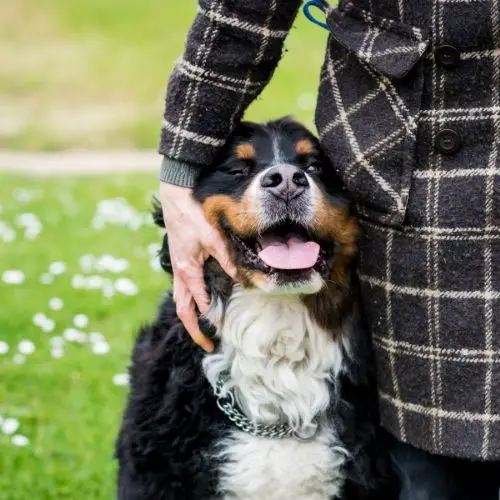
To understand do Bernese Mountain Dogs shed, you need to know a few thigs about their coat type.
Bernese Mountain Dogs are known for their gorgeous, thick double coat.
They have a long and wavy top coat that not just gives them the beautiful look but serves as weather protection and a thick undercoat that serves as weather insulation.
They also have a seasonal coat. In other words, their undercoat gets thick in winter, yet fairly light during the summer.
If you’re looking for a dog that’s up to the breed standard, there are not many coat colors available. Most will be tricolored, with a black base coat and tan and white markings.
This is a common color combination for all mountain dogs that originate from the Switzerland area.
Do Bernese Mountain Dogs Shed?
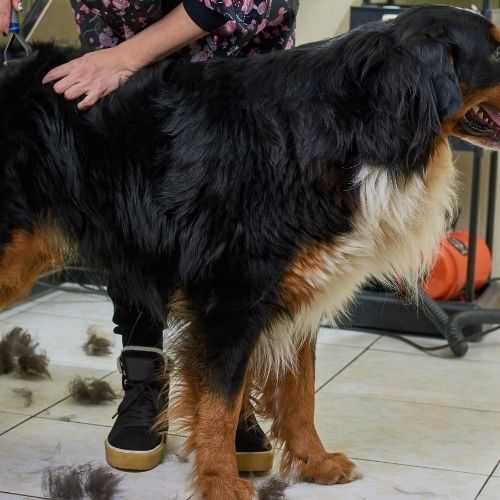
As you might’ve guessed just by looking at this magnificent doggie – yes, Bernese Mountain Dogs shed.
In fact, they are a high-shedding breed. They have a double coat, which means twice as many hairs to shed!
In fact, these pups are year-long shedders. This means they shed throughout the year. You can always expect to have some hairs to pick up and clean.
As their hairs are mostly black, this can be a nightmare for people with light-colored furniture or carpets.
Not just that, but because their coat is medium to long in length, the loose hairs are much more noticeable than hairs from a German Shepherd or a Golden Retriever.
They might shed just the same if not more than Newfoundlands!
At the same time, their shedding amount will increase during the shedding season, in the early summer and winter.
This is the time when the dog’s coat changes consistency, and it’s known as a blowing coat. Two times a year, a dog will shed his undercoat to make a way for a thinner or a thicker one, depending on the season.
During the shedding season, the dog will shed excessively. To manage the shedding, you’ll need to brush your dog daily.
The comb will catch all the loose hairs, keeping them from flying around. While there are other things you might do (that we’ll discuss a bit later), this is the most important one.
Are There Other Causes of Shedding?
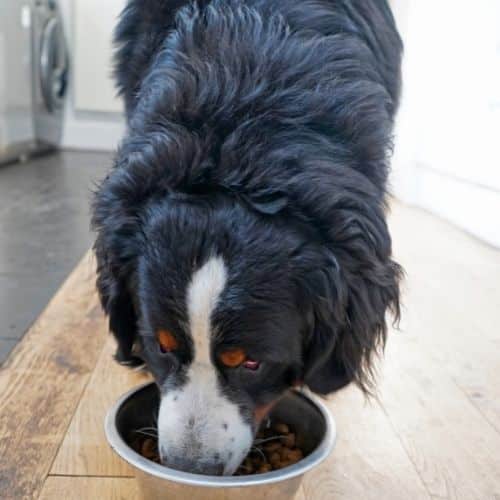
Some dog owners might have noticed irregular shedding. This might make them wonder do Bernese Mountain Dogs shed excessively for more reasons than just seasonal shedding.
In fact, there are more reasons why your Bernese might be shedding more than usual. This includes various things, such as:
- Stress
- Dietary changes
- Skin conditions
- Health problems
All of these things might impact the quality of your pooch’s fur, causing him to shed more than regularly. Let’s explain each factor a bit deeper:
Shedding due to Stress
Despite their large, unbothered appearance, Bernese Mountain Dogs are prone to anxiety and stress.
Separation anxiety is a common problem, for example, and even though it might seem benign for you, it can cause significant hair loss in canines.[1]
Not just that, but Bernese Mountain Dogs don’t do well with changes. Whether that be a change in their environment or a change in their routine, they’ll quickly feel stressed out.
This includes anything that keeps them from spending enough time with their family, or even welcoming a baby or a new pet in your household.
Shedding due to Dietary Changes
Changes in diet can stress out your dog’s body – even if the changes are made to improve the dog’s overall health.
Shedding is a natural response that the body is getting adjusting to new nutrients, or to the lack of them.
At the same time, Bernese have a sensitive stomach.
They are prone to food allergies – most notably allergies to grain and gluten – so if you’ve noticed your dog shedding more, you might consult your vet about switching to grain-free formulas.
Keep in mind that even after this dietary change your dog might temporarily keep on shedding until his body gets used to the new food.
Shedding due to Skin Conditions
Skin conditions are the most logical cause of excessive shedding. Due to their long coats, Bernese Mountain Dogs can have fleas, mites, and other parasites for a while without you noticing it.
These can cause wounds and dry skin that will result in shedding.
Bernese are also prone to skin allergies. For example, if you’ve given your dog a new type of food or bathed him with a new dog shampoo, he might react with a skin allergy.
Always pick a shampoo made for your dog skin type.
Shedding due to Health Problems
Finally, there are many health conditions that can cause hair loss in dogs.
This can range anywhere from mild health issues to severe diseases that can seriously endanger your dog’s health or even be fatal.
This includes not just skin conditions, such as demodectic mange, but even some seemingly unrelated problems such as hormonal imbalance or even cancer.[2]
If you notice your Bernese is losing his coat but his skin seems fine and you haven’t changed his diet, it’s essential to take him to the vet as soon as possible.
Chances are he is having some health problem that is otherwise being unnoticed.
How To Reduce Shedding
Now that you know do Bernese Mountain Dogs shed, you are likely wondering is there anything you can do to reduce the shedding amount.
While grooming is the most important step, there are a few other things you can do to help you out.
These include:
- Give your dog the best diet possible to ensure his body is healthy.
- Add supplements to his diet. Omega 6 and Omega 3 fatty acids are a great choice, and you can find them in fish oil.
- Make sure to use only shampoos and conditioners specifically designed for dogs. Human products can harm a dog’s skin.
- Don’t bathe your dog too often, as this can dry his skin out.
- Don’t skip vet visits. A dog’s health can easily be seen by the appearance of his coat. Most health conditions will ruin the fur quality, which can also cause hair loss.
How To Groom a Bernese Mountain Dog?
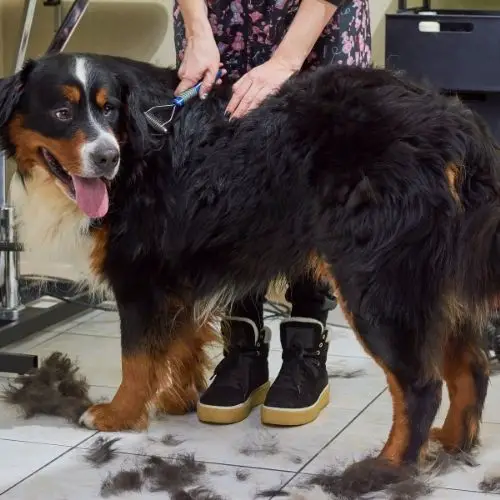
Dog grooming is an important part of being a dog owner. Whether you want to deal with your Bernese’s coat on your own or to take him to a groomer is up to you, but some brushing and bathing is essential.
In fact, many owners don’t even know can you cut a Bernese Mountain Dogs hair or how to trim Bernese Mountain Dog ears.
Once again, this is something that you can leave to a professional, but with just a few DIY tips and tricks you can save some money and time.
Here are some basic things you need to know about grooming a Bernese Mountain Dog:
Brushing
Brushing is a first line of defense against excessive shedding and it can make a huge difference. A comb will pick up any loose hairs and keep them from getting on your carpets, furniture, and clothes.
At the same time, brushing helps distribute natural body oils, making sure the skin and hairs are hydrated and shiny.
Throughout the year, you should brush your Bernese at least three times a week. This should be enough to make sure he doesn’t shed everywhere.
A good idea is to use a long pin brush as these work the best with long-haired dogs. While you can use a bristle brush, their short pins might not be enough to reach the dog’s undercoat and untangle it.
As most dead hairs stay in the undercoat, you’ll need a brush with long enough pins to reach deep into the fur. Pin brushes are a great choice for this.
You might also use some deshedding tool, as these are a great option for shedding breeds. Just remember to use it sparingly, as it has somewhat sharper pins than a regular brush.
If you use it excessively, it might irritate the dog’s skin.
During the shedding seasons, as we’ve mentioned, daily brushing is recommended. If this sounds like too much work, at least brush your pup every other day.
Anything less than that will result not just in dirty floors, but also in lots of mats and tangles.
Bathing
Bathing is another important part of dog grooming you really shouldn’t forget about. This can further help with loose hairs, and it can also keep your pup free from parasites.
However, it’s essential to have in mind that excessive bathing can do more harm than good.
Water alone can make the dog’s skin drier than normally, not to mention that shampoos can irritate his skin. Bathing can also disrupt his natural oil distribution, which is not good.
Overall, you shouldn’t bathe your Bernese Mountain dog more often than once a month.
Of course, if your dog gets in the mud or if he is very dirty, you’ll have to bathe him then. However, bathing him more common than monthly won’t do anything for his coat.
This will simply help clean him up and make him smell better.
Don’t Forget His Ears, Nails and Teeth
This grooming tip doesn’t have anything to do with Bernese Mountain dog shedding, but we still feel like we have to mention it.
Many dog owners forget to include maintaining of other dog’s body parts in their grooming session. This includes activities such as:
- Brushing his teeth.
- Nail clipping.
- Ear cleaning.
You should brush your dog’s teeth at least once a week. They could drool a lot! As Bernese has floppy ears, this is also a good time to check his ears for infections and irritations.
Also, clip his nails whenever you see that they have started curling inwards.
Forgetting to do these three tasks can cause serious harm to your dog’s health in the long run.
Should You Cut a Bernese Mountain Dog’s Fur?
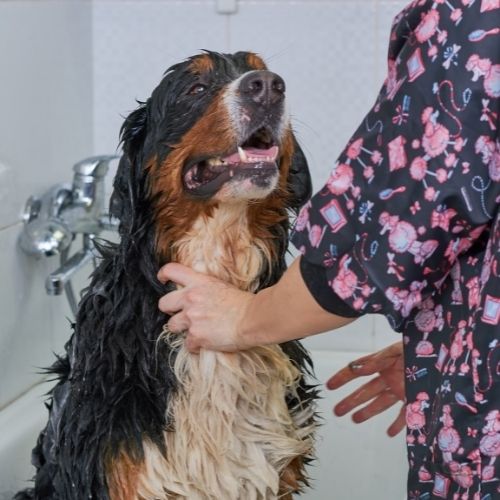
While you can make a fun Bernese Mountain Dog summer cut, believe it or not this won’t make as many changes as some good grooming and regular brushing.
Their long coat doesn’t make them hot in summer, and if you do choose to cut their coats short this should be for fun only.
However, one thing you shouldn’t do is shave his coat, no matter how hot it is outside. Bernese Mountain Dog’s coat has great insulation properties.
This doesn’t include just keeping him warm in the winter. His double coat also keeps him from getting too hot in the summer.
If you cut his coat too short, he’ll lose the weather protection he has. As such, you’ll only make him feel worse.
Not just that, but if you shave his coat, you’ll leave his sensitive skin exposed to sun damage. This increases your pooch’s chances of developing skin conditions such as skin cancer.[3]
Read Also: Do Dogs Eat Mice
Do Bernese Mountain Dogs Shed – Final Word
Bernese Mountain Dogs are a shedding breed that might be challenging to maintain. You need to brush them regularly and to take good care of his long and wavy double coat.
If you want to get this dog breed, be prepared to have black hairs everywhere!
Learning do Bernese Mountain Dogs Shed shouldn’t impact your overall decision on owning this dog breed, though.
These are amazingly gentle dogs that will love their owners with all their hearts. As long as you have a big yard and a bit of patience for cleaning up hairs, you’ll get yourself an amazing pet that will always be there for you.
Read Next: Are Chihuahuas Smart
